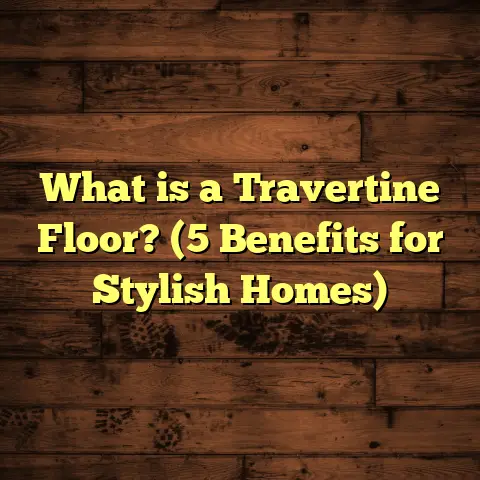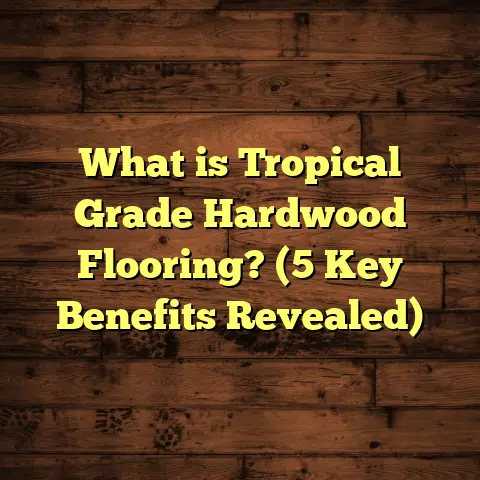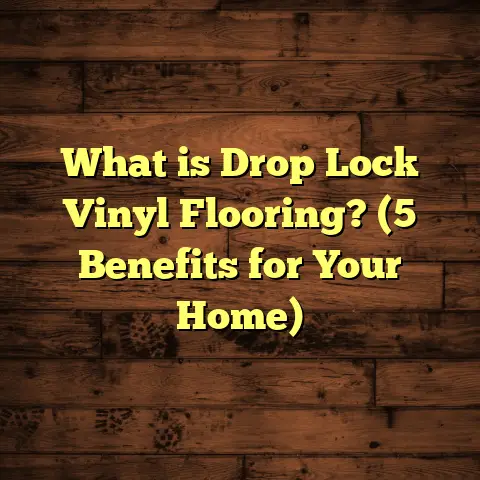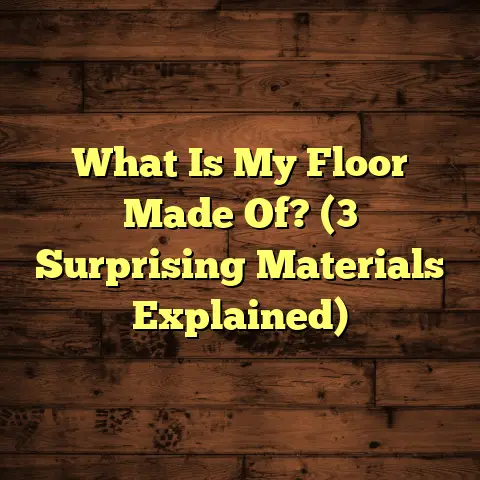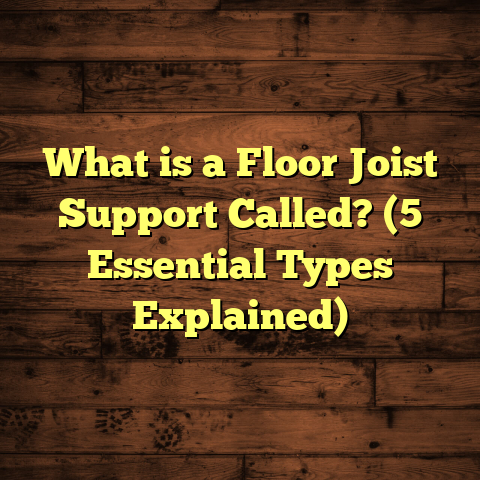What is Hardwood-Look Flooring? (5 Facts You Must Know!)
Have you ever stepped into a room and immediately felt a sense of warmth and nostalgia wash over you just by looking at the floor? Maybe it reminded you of your grandparents’ cozy living room or that charming cabin you visited during childhood vacations. There’s something timeless about the look of wood beneath your feet—it seems to tell a story all on its own. But what if you don’t want to deal with the high costs, maintenance, or vulnerability of real hardwood but still crave that authentic wood appearance? That’s where hardwood-look flooring comes into play. Over the years, I’ve worked closely with many homeowners and contractors who are fascinated by this option, so I want to share everything I’ve learned about what hardwood-look flooring really is, why it’s so popular, and how to make the right choice for your home.
What is Hardwood-Look Flooring?
Let’s start with the basics. You might ask yourself, “What exactly is hardwood-look flooring?” Simply put, hardwood-look flooring refers to any type of floor covering designed to mimic the color, texture, and grain patterns of natural hardwood but made from other materials. These materials can include laminate, luxury vinyl planks (LVP), and engineered wood. Each has its own unique construction method and benefits but shares the goal of replicating the classic aesthetic of hardwood floors.
For example, laminate flooring uses a photographic image layer that realistically mimics wood grain and color variations. This image is sealed under a durable protective coating to resist scratches and wear. Luxury vinyl plank flooring features high-definition printing combined with embossing techniques to create a textured surface that feels just like real wood underfoot. Engineered wood, on the other hand, contains a top layer of real hardwood veneer bonded over composite plywood layers, offering both stability and an authentic wood surface.
From my hands-on experience, these materials have been game changers for homeowners seeking the charm of hardwood without some of the traditional drawbacks like high cost, susceptibility to moisture damage, and complex installation.
Fact 1: It Offers Realistic Wood Aesthetics Without the Cost of Real Hardwood
One of the biggest reasons people lean towards hardwood-look flooring is cost. Real hardwood floors are undeniably beautiful but can be expensive to purchase and install. Depending on the species—think walnut, cherry, or oak—prices can range from $8 to $15 or more per square foot just for materials. Add labor costs and any needed subfloor prep, and a full-room installation can easily reach several thousand dollars.
Hardwood-look options like laminate or LVP typically cost between $2 and $7 per square foot for materials alone. Installation costs vary but can be lower because many come in “floating” styles that don’t require nails or glue, reducing labor hours.
To give you an idea, when I helped a family redo their entire 1,200-square-foot home with laminate flooring last year, they saved about $6,000 compared to if they’d chosen solid hardwood. The floors looked stunning — they chose a deep espresso oak style — and held up well even with kids and pets running around.
This price difference is not just about upfront savings. It also impacts your ability to upgrade other parts of your home or choose higher-end finishes elsewhere since you’re not breaking the bank on floors alone.
Fact 2: Different Types of Hardwood-Look Flooring Serve Different Needs
It’s not all one-size-fits-all when it comes to hardwood-look options. Each material brings something different to the table in terms of durability, feel, moisture resistance, and installation requirements.
Laminate Flooring
Laminate is one of the most popular hardwood alternatives because it balances cost-effectiveness with realistic visuals. It consists of multiple layers:
- A wear layer on top protects against scratches and stains.
- Below that is a photographic layer that replicates wood grain.
- A core layer made from high-density fiberboard provides structure.
- The bottom layer stabilizes moisture and keeps the plank flat.
Laminate typically offers great scratch resistance but isn’t waterproof. Water exposure can cause swelling or warping over time if spills aren’t cleaned quickly. I usually recommend it for living rooms, bedrooms, and hallways rather than bathrooms or basements.
Luxury Vinyl Plank (LVP)
LVP has gained huge popularity recently because of its excellent water resistance and durability. Composed primarily of PVC vinyl with a rigid core in many models, it feels softer underfoot than laminate and can be installed almost anywhere in the house—even wet areas like bathrooms and kitchens.
The printing quality is amazing today; some planks are embossed with textures matching real wood grain closely enough that even experts have trouble telling them apart from genuine hardwood without close inspection.
From my projects, clients love LVP for active households due to its resilience against scratches, dents, and moisture.
Engineered Wood
Engineered hardwood flooring blends real wood’s beauty with enhanced stability. It has a thin veneer layer of real hardwood (usually 2-6 mm thick) bonded on top of plywood layers arranged in cross-grain fashion to prevent expansion and contraction from temperature changes.
I often suggest engineered wood for areas where traditional hardwood might struggle due to humidity—like basements or kitchens—while still wanting authentic wood underfoot.
Installation methods vary: floating floors using click-lock systems, glue-down applications for better adhesion on concrete slabs, or traditional nail-down methods on wooden subfloors.
Fact 3: Installation Can Be Easier—and More Flexible—Than Solid Hardwood
One thing I’ve noticed over the years is how much easier it can be to install hardwood-look flooring compared to solid wood. This factor alone makes it attractive to DIY enthusiasts and professionals alike.
For instance:
- Click-Lock Systems: Most laminate and many LVP products come with click-lock edges that snap together without nails or glue. This floating floor method reduces installation time dramatically.
- Adhesive Options: Some vinyl products are peel-and-stick or glued down, giving options depending on floor condition and homeowner preference.
- Less Subfloor Preparation: Unlike hardwood floors which require perfectly smooth subfloors free from any debris or imperfections, many hardwood-look options tolerate minor flaws better.
In one project I worked on involving a rental property renovation, we installed LVP flooring over existing vinyl tiles after leveling only minor dips with patching compound. This saved weeks compared to removing old floors and refinishing traditional hardwood.
Fact 4: Maintenance Is Simple but Requires Some Care
If you’re anything like me, ease of maintenance is a big deal when choosing floors. Hardwood-look flooring usually scores high here—especially compared to solid wood that needs periodic refinishing and special cleaning products.
With laminate and vinyl:
- Regular sweeping or vacuuming keeps dust and grit from scratching surfaces.
- Damp mopping with water-based cleaners recommended by manufacturers keeps floors clean.
- Avoid soaking floors with water.
- Use felt pads under furniture legs.
- Clean spills promptly.
Engineered wood needs slightly more care due to its real wood surface but still less than solid hardwood. I advise clients to avoid harsh chemicals and use pH-neutral cleaners designed for wood.
In my experience managing rental properties with laminate flooring installed for tenants, simple maintenance routines keep floors looking great well past 10 years without any costly repairs or refinishing.
Fact 5: The Market Is Growing Fast Because People Love Flexibility Without Losing Style
Here’s a fun fact: industry data shows that sales of hardwood-look flooring materials have surged over 30% in the last five years in North America alone. Why? Because they deliver style without sacrifice.
Many homeowners want their floors to look beautiful but need durability for busy lives. Hardwood-look floors fit that bill perfectly.
A recent survey by Floor Focus magazine revealed:
- 68% of homeowners chose hardwood-look options because they required less maintenance.
- 54% appreciated the waterproof qualities.
- 47% cited cost savings as key.
- 35% liked that they could install it themselves or easily find contractors who specialize in these materials.
I’ve personally seen this trend firsthand on countless projects—from small apartments opting for LVP after flooding issues in neighboring units to large family homes choosing engineered wood for consistent looks across multiple rooms with different humidity levels.
How I Help Homeowners Choose Hardwood-Look Flooring
Over my years in this business, I’ve developed a simple approach when advising clients about hardwood-look floors:
Step 1: Understand Your Space
Where will the floor go? Kitchens and bathrooms need moisture-resistant options like vinyl or waterproof laminate. Living rooms and bedrooms can handle laminate or engineered wood easily.
Step 2: Consider Budget
Do you want to spend less upfront but still get good durability? Laminate is often best for tight budgets. Got room for more investment? Engineered wood offers real wood surfaces at lower prices than solid hardwood.
Step 3: Think About Lifestyle
Kids? Pets? High traffic? These factors push me towards more durable options like LVP or laminate with thick wear layers.
Step 4: Choose Style
Wood species (oak, hickory, walnut), plank width (narrow strips vs wide planks), finish (matte vs glossy), and color temperature (warm browns vs cool grays) matter here. Bring home samples and see them in your lighting before deciding.
Step 5: Plan Installation
Do you want to do it yourself? Floating click-lock styles are best. Need professional help? Glue-down or nail-down may be better depending on subfloor type.
Detailed Insights from My Projects
Let me share two detailed examples from my recent work that highlight how hardwood-look flooring can meet different needs perfectly:
Case Study 1: Family-Friendly Laminate in a Busy Household
The Johnson family had three kids under ten plus a golden retriever. They wanted oak flooring’s look but knew solid wood would get scratched too fast. I recommended a high-quality laminate with an embossed texture simulating white oak grain.
We installed it over their existing plywood subfloor using click-lock planks with attached underlayment for sound absorption. The family loved how quickly we finished installation over a weekend.
Two years later, no scratches deeper than surface marks showed up despite heavy use. Cleanup was easy after spills from juice boxes or muddy paws.
Case Study 2: Luxury Vinyl Plank in Coastal Condo
A couple living near the coast wanted the warmth of wood but faced humidity issues that damaged previous solid hardwood floors. We chose rigid-core LVP in wide planks mimicking natural walnut with hand-scraped textures.
The waterproof nature meant no worries about moisture seeping under the floor during storms. They also appreciated how quiet it was underfoot compared to tile or laminate alternatives.
After four years, their floor still looks great despite sand tracked in from beach visits daily—a testament to vinyl’s durability in tough environments.
Common Questions I Hear About Hardwood-Look Flooring
Here are some frequent questions friends and clients ask me:
Q: Can I refinish laminate or LVP if damaged?
A: Unlike solid wood, these materials cannot be sanded or refinished. Individual planks can be replaced though if damage occurs.
Q: Will hardwood-look flooring increase my home’s resale value?
A: It depends on your market but many buyers appreciate these floors because they look stylish yet hold up well over time.
Q: Is engineered wood considered “real” hardwood?
A: Yes! Engineered wood has a genuine hardwood top layer but improved stability due to plywood core layers underneath.
Q: How long does hardwood-look flooring last?
A: Laminate typically lasts 10-20 years; LVP can last 20+; engineered wood around 20 years depending on wear and care.
Q: Are these floors eco-friendly?
A: Some brands use recycled materials or sustainable sources. Engineered wood uses less rare hardwood per plank than solid floors.
The Science Behind Hardwood-Look Flooring Materials
Let’s get technical for a moment because understanding material science helps explain why these floors work so well:
- Laminate Core: Made from High-Density Fiberboard (HDF) compressed under heat creates a strong yet lightweight base that resists dents better than particleboard used in cheaper laminates.
- Wear Layer: Usually melamine resin with aluminum oxide particles adds scratch resistance far beyond natural wood finishes.
- Printing Technology: Advances in digital printing allow ultra-high-resolution images that replicate knots, grain direction changes, and color variations found in real wood—even pores visible on close inspection.
- Vinyl Composition: Polyvinyl chloride (PVC) combined with plasticizers makes LVP flexible yet tough; rigid cores often contain limestone fillers for strength without added weight.
These technological advances have made today’s hardwood-look floors almost indistinguishable from natural hardwood to the naked eye—and much more practical for everyday living conditions.
Tips for Choosing the Right Hardwood-Look Flooring Brand
With so many brands available now, how do you pick one that delivers quality?
- Check Reviews & Ratings: Look beyond marketing hype; check verified customer feedback on scratch resistance and color fade over time.
- Warranty Coverage: Good brands offer at least 10-year wear warranties; some premium lines cover water damage too.
- Sample Testing: Order samples early; test them by dragging furniture across them or exposing samples to water briefly at home before committing.
- Customer Support: Brands that provide strong technical support help solve installation or maintenance questions faster—a lifesaver during tricky jobs.
How Hardwood-Look Flooring Fits into Design Trends
What styles are trending? Here’s what I’m seeing:
- Wide Planks: Wider boards (6”-9”+) create an open feel popular in modern rustic designs.
- Gray Tones: Soft gray hues blend well with contemporary interiors while hiding dirt better than lighter woods.
- Hand-Scraped & Textured Finishes: Adds character mimicking aged hardwood floors with natural imperfections.
Choosing finishes like matte or low sheen is rising too since they reduce reflective glare making spaces feel cozy instead of shiny showroom-like.
Final Thoughts from My Toolbox
I hope this detailed look at hardwood-look flooring helps you understand why it’s become such a favorite option among homeowners today. It offers a beautiful balance between style, durability, ease of maintenance, and affordability without losing that classic warmth only wood can bring to your home environment.
If you’re considering new floors soon:
- Think about where you’ll use them.
- Balance budget with lifestyle needs.
- Bring samples home.
- Don’t hesitate to ask questions about installation methods.
- Remember maintenance routines will keep your floors looking new longer than you expect!
And if you want someone experienced who knows these products inside out—someone who’s walked dozens of installation sites and helped families pick just the right floor—reach out anytime. I love sharing what works best based on real-world experience rather than just specs on paper.
Thanks for reading! If you have any questions or want recommendations tailored specifically for your project, just ask—I’m happy to help you get those floors that feel just right every time you step inside your home.
